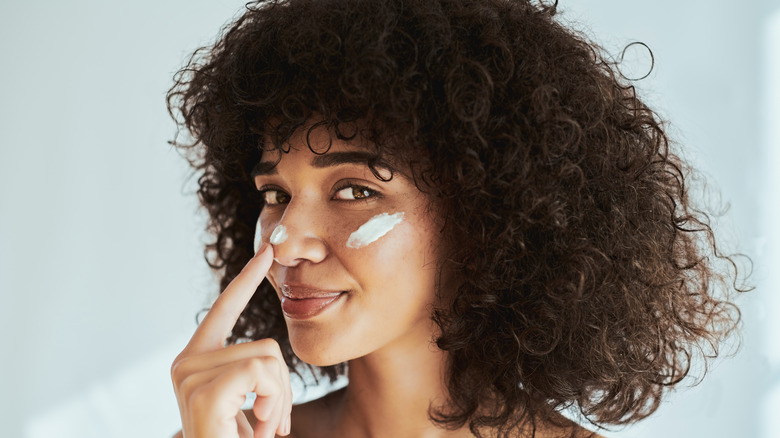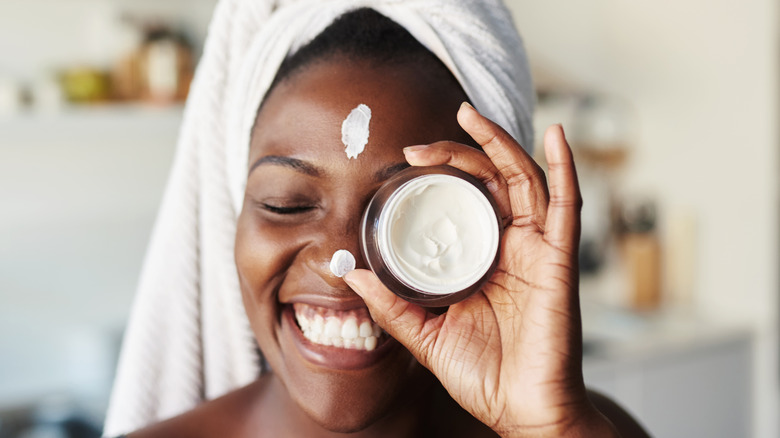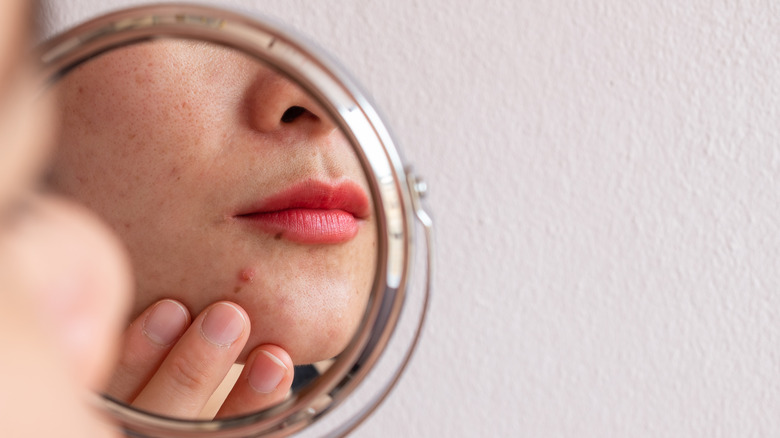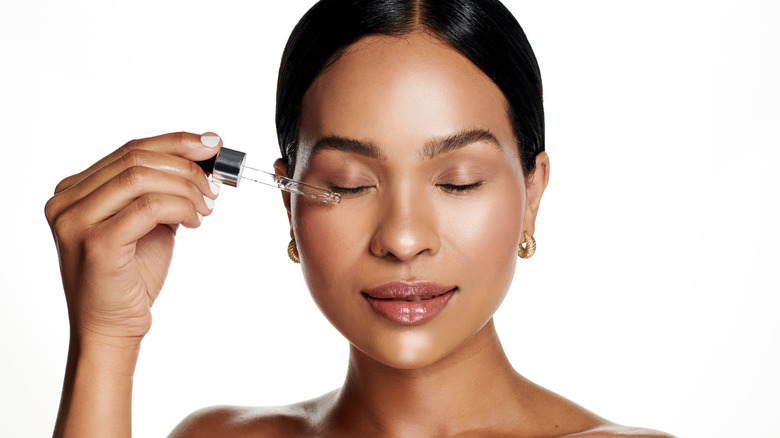6 Timeless Tips That'll Up Your Skincare Game
When it comes to skincare, it's best to approach it with a "less is more" mindset. After all, putting too many things on your face heightens the risk of breakouts, allergic reactions, and skin congestion. Yet, not only is the skincare industry pumping out new products every day, but no one's skin is one-size-fits-all. Learning to tailor your skincare routine into something that's best for you takes a lot of work.
To truly know what products work best typically requires research. The art of skincare is a science — if you want to transform your skin, it may take more than just the basics to see the results you're looking for. If you don't have the time to figure out the products that work best for your skin, we're here to cut out the guesswork. Read ahead to learn the best tips to level up your skincare game.
Nothing works without SPF
The sun plays a vital role in the life of the Earth. It grows our food and provides warmth and light. However, its UV rays are harmful to our skin. Sunscreen is the most important step in your daily skincare routine. Without its presence, all the actives, serums, and treatments you apply are rendered useless.
For example, you may turn to chemical exfoliation or retinol to rid your skin of hyperpigmentation or reduce fine lines. Not only does this make your skin more sensitive to the sun, but UV rays cause premature aging and darken discoloration. Spending time targeting uneven tone and texture won't work unless you have SPF to prevent the sun from worsening your skin.
To get the most protection, never use sunscreen below 30 SPF. Whenever you're outside or your face sees the sun, reapply sunscreen every two hours. It can be annoying to rub it in often, but there are other SPFs outside of traditional sunscreens that you can use instead. Opt for a stick sunscreen or spray-on SPF for easy reapplication.
Try before you buy (a full size)
It's easy to get swept away by the editorialized marketing and influencer reviews of trendy skincare products. Some people may swear up and down that a serum or moisturizer changed their life. However, the impressive results could be due to editing magic or simply the fact that they have different skin than yours. If you're thinking of purchasing a new product, try to sample or start out with a smaller size first.
Not only does this give you the chance to see if you actually like the product, but it gives you the opportunity to patch test before diving into a large size. To patch test, apply a pea-sized amount of product to clean, dry skin. Watch the area for about 24 hours; if you experience any irritation, redness, or inflammation, discontinue the use of it.
When testing a product to know if it's actually effective, you're not going to see any overnight changes. It takes a few weeks to see a difference in your skin. Within that amount of time, you'll be close to finishing the mini or travel size. From there, you'll know whether to spring for the full size or move on to something else.
Acne map for clearer skin
People with acne-prone skin may be used to acne flare-ups frequently. But if you only get the occasional breakout here and there, pinning down the source of each pimple takes more work. Stemming from ancient Chinese and Ayurvedic medicine, acne face mapping breaks down the face into sections to help you pinpoint what's causing your breakout.
Starting with the upper part of the forehead, zits along the hairline and temples may be a result of hair products or makeup. It's easy for the products you put in the front of your hair to find their way down to your skin. Additionally, you may not be washing your face all the way up to your hairline, leaving lingering makeup that results in breakouts. Further down, acne in the T zone area can be caused by excessive oil, since this is where it's produced the most.
Acne on the cheeks can be a reminder to wash your pillowcases and clean your phone screen. With these two surfaces always being pushed against your face, any dirt or contaminants on them are in constant contact with your face, resulting in breakouts. As for the jawline, you may notice that you tend to break out there every time you get your period. Chin and jaw acne is indicative of hormonal acne. To deal with breakouts, use beta-hydroxy acids (BHAs) like salicylic acid and avoid popping your pimples. Prevent the urge to pop by covering them up with pimple patches.
Cleanse twice at night, but not in the morning
Whether you wear makeup every day or not, it's still important to double cleanse in the evening. Since you should be donning SPF daily, getting rid of it with your regular face wash alone is difficult. Most sunscreens are water-resistant, so using a water-based cleanser to remove all of it won't always work. Just to ensure that everything is really gone, wash your face with an oil-based cleanser and then follow up with a cleanser or face wash.
In the mornings, rinse your face with water instead of going back in with a cleanser. While you certainly don't have to adhere to this rule, you may find that skipping face wash in the a.m. may help with oil control, sensitivity, and the appearance of pores. If you suffer from acne, use a mild face wash instead. You can also swipe on some rose water toner with a cotton pad in lieu of cleansing.
Rose water possesses a range of benefits for the skin — it has antimicrobial and anti-inflammatory properties that make it a great morning cleanser alternative. It's hydrating and contains antioxidants that improve your skin tone over time. Afterward, follow up with your regular morning routine.
Learn which exfoliant is right for you
Chemical exfoliation has been popular in the skincare world for a few years now. In basic terms, chemical exfoliants are acids that shed dead skin cells from the surface of your skin. While your skin already does this process on its own, chemical exfoliation speeds it up, especially when things like sun exposure and aging can slow it down.
There are many benefits to chemically exfoliating, but you have to determine which specific exfoliant is best for your skin type. Alpha-hydroxy acids (AHAs) are one of the most popular forms of acids — they tend to be gentle and are naturally occurring. Glycolic acid, a common version of AHA, helps to manage acne and improve skin texture. However, it's not always compatible with dark skin. Instead, opt for mandelic acid, an AHA which is non-irritating and doesn't run the risk of darkening discoloration like glycolic acid.
BHAs are stronger than AHAs and go deeper under the surface of the skin to exfoliate. Salicylic acid is the most commonly used form of BHA. Other BHAs include tropic acid, threthocanic acid, and beta hydroxybutanoic acid. BHAs are great for excessively oily and acne-prone skin. It works to clear out the pores, reducing their appearance while clearing up acne. BHAs can be quite strong, and like other acids, should be reserved for the evening.
It's the inside that counts
The things you put in your body can reflect on your face. Even if you use the best products, wash your face religiously, and reapply SPF constantly, a poor diet can prevent you from getting the skin that you want. If you tend to break out even with a good skincare routine, the food you consume could be the culprit.
Processed foods that have been fried or are filled with salt and sugar are typically to blame for constant breakouts. Dairy and red meat may also contribute to your acne. While red meat contains an acid called leucine that's linked to breakouts, scientists are still trying to pin down the correlation between dairy and acne.
If you're fighting off acne, a diet rich in zinc and vitamins A and E may help you out. Swap out white flour for whole grains and unprocessed fruits and veggies. Eating foods with vitamin C can brighten up dull skin and reduce inflammation from the inside out. Things like strawberries, citrus, bell peppers, and broccoli can help with aging and dull skin. Omega-3 fatty acids can also do the same, in addition to boosting your collagen production. Eating tuna, salmon, almonds, and chia seeds may also lead to better skin.






